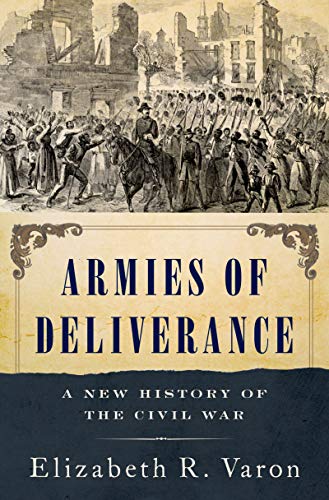


Armies of Deliverance: A New History of the Civil War by Elizabeth R. Varon (Oxford University Press, 2019)

Dr. Varon is the Langbourne M. Williams Professor of American History at the University of Virginia—certainly a prestigious posting that would suggest cutting-edge scholarship is the norm. So it was with some high expectations that I accepted a review copy of the manuscript. It made my READ list because it was from Oxford Press and I had not read Varon before. The attraction was “A New History of the Civil War.” I asked myself, Was that possible? Since it had been a number of years since I had read a general history of the war, it seemed a good time to try one. While a thought-provoking monograph, however, it was far from a “New History.”
What Armies of Deliverance is, is a slim segment of the progress of the war through the eyes of a minority section of the northern populace—not fully abolitionist but absolutely a northern view of the war and its consequences. I was lucky though, having just finished and reporting on Fergus Bordewich’s book Congress at War, about the Radicals in Congress, this book was an easier read than it might have otherwise been. I would think then the two titles ought to go hand in glove for a robust treatment of this thread of thinking.
A few years ago, I went to a Society of Civil War Historians meeting, in which a group discussion was packed to the gills to discuss the question of whether a discussion of the Civil War should include military history. On the surface, you superficially would respond as most of the people there did—yes, of course! Well, would a written history of the Civil War need to include military history? Varon’s narrative minimizes that, in that the use of military actions are secondary except to highlight the use of the military as an instrument of “Deliverance.”
My problem with this theory is that it is not how the rank-and-file soldiers of the North viewed themselves, nor did many of the leading politicians and generals. This does not suggest that the basis for Varon’s book is a soft one. It isn’t, but the war was not fought for Deliverance, and had military actions or early assumptions about the nature of the southern people been accurate, the war would have ended much sooner and the acrimony that accompanied the reunification of the country for more than 150 years would not be so strong. A counterpunch I have heard long before I heard about Deliverance was that the bitterness stems from the fact that the South was an occupied country. Given the degree of social unrest that occurred in that time, “Deliverance” seems to be a strong descriptor for what happened.
Accepting Varon’s credentials and her well-considered presentation the book is hardly without merit. The result of the war was Deliverance for a race of people who had no rights previously. There was a seachange of legal documentation that began the torturous route to civil rights that many of us witnessed in the 1950s and 1960s.
Varon also attempts to make the case, if less persuasively, that southern society itself was Delivered. In this instance she suggests the war saved an ignorant society from itself, along with those who, given enough time, would have been “taken for a ride” by a very small and selfish cadre of southern oligarchs. What we have, then, is a narrative of the war that reminds me much of the symbolic sculpture at the Corinth Civil War Interpretative Center, with an emphasis on battles where African Americans fought as a central element. It was not wrong, but it certainly would have synchronized well with Varon’s thesis.

The book is intellectually rigorous, but I would not recommend it as a sole source for understanding the war. As a single standalone, James MacPherson’s Pulitzer Prize-winning contribution to the Oxford series on American history—Battle Cry of Freedom—is still the standard integrated work even 33 years after it was published. That said, if you are well read on the war, then the reward of Armies of Deliverance is that the author has more than competently laid out a longstanding but less appreciated legacy of the war. It was a moment of Deliverance, BUT at the time very few people could or would have gone to war to achieve that. Not even Abraham Lincoln would have tackled that social and moral challenge had the course of military operations not compelled him to use his authority as “Commander in Chief”—a heretofore undefined constitutional power granted to the President. Even then, Lincoln pursued emancipation as a means of stripping the South of its most dynamic resource—human sweat—and warning off lurking foreign interests from involving themselves in a war that was now about a “New Birth of Freedom.”
I am not alone in my witness to the inadequacy of the thesis of “Deliverance.” Varon finishes very strong in her final chapters after Appomattox by quoting Frederick Douglass talking about Reconstruction: “But let the civil power of the states be restored, and the old prejudices and hostility to the Negro will revive.” A bloody, bloody and dark series of postwar generations proved him prescient.
I recommend this book for advanced students of the war who are able and willing to think critically. I do not think it is a suitable general history or as a standalone for new students of the war. I do not believe Varon has proven the thesis. There is too much evidence to the contrary. Conversely, she has served an important purpose in the monograph by raising issues that deserve an airing and robust discussion because we can play out “Deliverance” through 155 years of experience. Academics and ideologues may make the point, but life and reality have a strange way of contradicting theories. Byproducts cannot be presumed to be the intended outcomes from the start of the effort. A race was delivered to a long and difficult future within a society that certainly didn’t see “Deliverance” as either a good thing or a socially acceptable one. Thus, I cannot conclude that the war was intended as a War of Deliverance. It was a War for Union with real and dramatic consequences derived from a violent passage and clash of arms.
